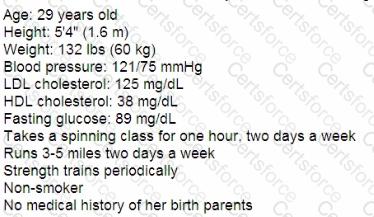A client with a blood pressure of 124/94 mm Hg would be considered:
Your client, who is a golfer, is throwing a weighted ball against a wall. The client is facing away from the wall so that he must rotate his trunk in order to toss the ball. This activity BEST represents the __________ principle.
While supervising Louise's strength training exercises, the personal trainer notices that her posture shows mild kyphosis. Which of the following is the appropriate course of action?
Which of the following is a criterion for terminating a submaximal-graded exercise test?
A person is considered to have systolic hypertension if he or she:
What enables a client to successfully deal with high-risk situations that may reduce adherence?
Your new client stands with the palms of his hands facing in a posterior direction. What condition could be attributing to this position?
Maria is experiencing pain around her knee when she runs for more than 20 minutes. This began three weeks ago, so she decides to ask you for advice. What should you do?
Implementing a year-long strength-training program that adjusts loads, sets, and repetitions is called:
A new female client's health history reveals the following Information:

Using the client's health history, how many positive risk factors are present?